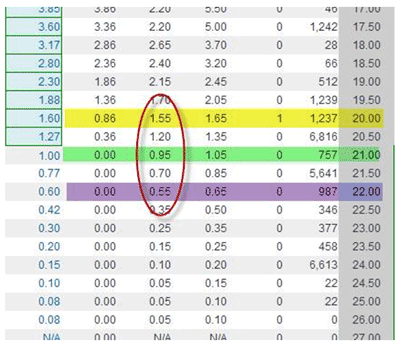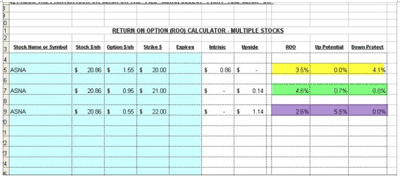Alan Ellman of The Blue Collar Investor uses market examples to explain how options are valued, a skill that will allow traders to select the options and strike prices with the most profit potential.
When studying option trading basics, a critical formula is:
Option premium = intrinsic value + time value (or extrinsic value)
This past week, I hosted a seminar in New York and there were many inquiries regarding the difference between intrinsic and extrinsic value, so I felt an article would be appropriate.
There are three types of strike prices as they relate to the stock price:
- At the money (ATM)
- In the money (ITM)
- Out of the money (OTM)
The ATM strike is when the strike price and current market value are the same. An example would be when you buy a stock for $50 and sell the $50 call option.
The ITM strike is when the strike price is less than the current market value of the stock. An example would be when you buy a stock for $56 and sell the $50 call option.
The OTM strike is when the strike price is higher than the current market value of the stock. An example would be when you buy a stock for $48 and sell the $50 call option.
Of these three types of strike prices, only the ITM strike has intrinsic or inherent value. In the example above, if we sold the $50 call when the stock was trading at $56, the option buyer could exercise that option, buy it from us @ $50, and sell it at market for $56, generating a $6 profit.
In this case, the intrinsic or inherent value is $6. The ATM and OTM strikes have no intrinsic value, so those options consist only of time value or extrinsic value.
Let me give some examples:
ATM: Buy a stock for $50 and sell the $50 call for $1.50. The premium is all time value (our initial profit) and represents a 3% initial return ($1.50/$50).
ITM: Buy a stock for $56 and sell the $50 call for $8. The premium breakdown is as follows:
Option premium ($8) = Intrinsic value ($6) + time value ($2).
Our initial profit is not $8 because we will be losing $6 on the sale of the shares. Therefore, when calculating our initial profit for an ITM strike, we deduct the intrinsic value from the premium and the resulting time value is our real initial profit, in this case $2.
OTM: Buy a stock for $48 and sell the $50 call for $1.20. The premium is all time value as in the ATM example. In this case, $1.20 represents a 2.5% initial return ($1.20/$48).
NOTE: Do not include intrinsic value when calculating your initial option returns. For those of you who have access to the Ellman Calculator, these calculations will be automatically done for you after entering the information from the options chain.
Pros and Cons of Each Strike Type
ATM
- Generates the highest initial option return
- No upside potential from share appreciation
- No downside protection of the option profit (time value)
ITM
- Generates a lower initial return than ATM strikes
- No upside potential from share appreciation
- Provides protection of the option initial profit from the current market value down to the strike price ($46 of protection from the above ITM example)
OTM
- Generates a lower initial option return than the ATM strike
- No downside protection of the option initial profit
- Does provide upside potential for share appreciation from the current market value up to the strike price sold ($2 per share in the above OTM example)
I use ATM and OTM strikes when I am bullish about the stock and overall market conditions. I favor ITM strikes when I’m bearish about the overall market or when the technicals of the stock are mixed.
Strikes can be “laddered” in most market conditions where you select a mix of strike types. The mix can be an equal number of each, or favoring one type depending on market assessment and your personal risk tolerance. More conservative investors will favor ITM strikes.
NEXT: Review a Real Market Example
|pagebreak|Real Market Example
Let’s take a look at the options chain (June contracts) for a stock currently on our watch list, Ascena Retail Group, Inc. (ASNA):
Note the following*:
- ITM $20 strike generates $1.55 (yellow)
- ATM (near the money) $21 strike generates $0.95 (green)
- OTM $22 strike generates $0.55 (purple)
*These are all per-share stats. Multiply by 100 to get per-contract stats.
Next we feed this information into the single or multiple tabs of the Ellman Calculator (blue cells) and the results are shown below:
Note the following:
- The $20 ITM strike generates an initial 3.5% return with 4.1% protection of that profit (yellow)
- The $21 ATM (near-the-money) strike generates the highest initial return of 4.6% but very little upside and no downside protection of that profit (green)
- The $22 OTM strike generates a 2.6% initial return with another 5.5% upside potential if the shares appreciate higher. This represents a potential 8.1% five-week return (purple)
Conclusion
Option premium consists of intrinsic value (ITM strikes only) + time (extrinsic) value. Only the time value represents our initial profit. Understanding the pros and cons of each strike type and basing our selections on chart technicals as well as overall market assessment will allow us to raise our profit returns to the highest possible levels.
By Alan Ellman of TheBlueCollarInvestor.com












